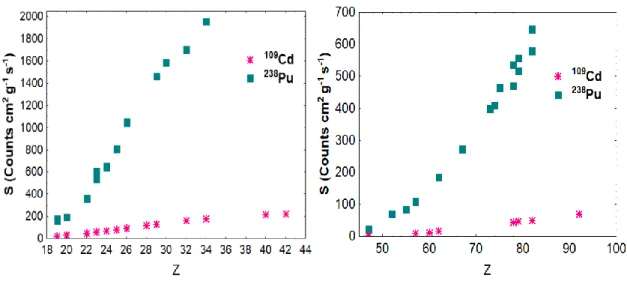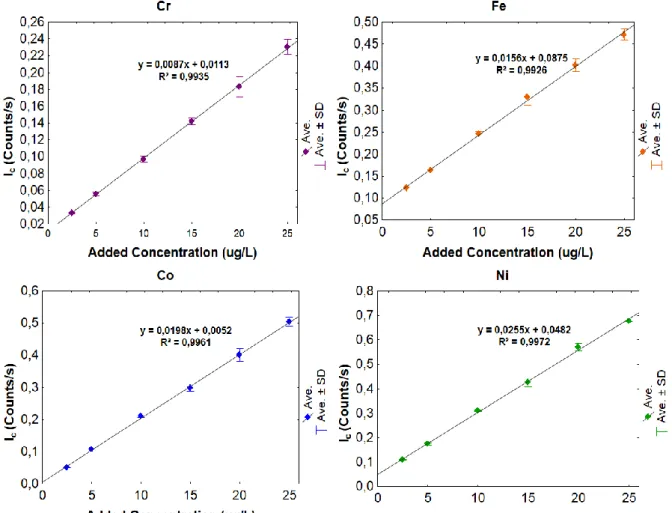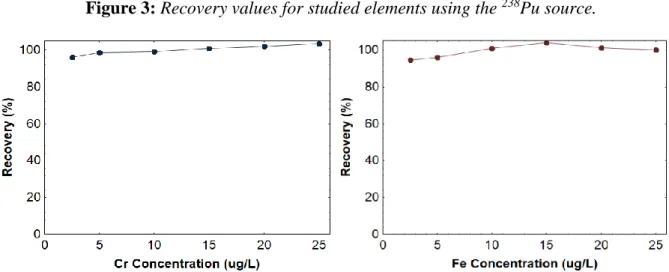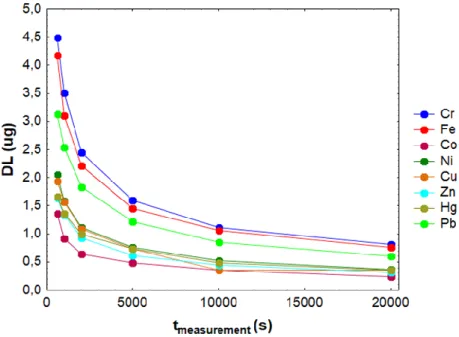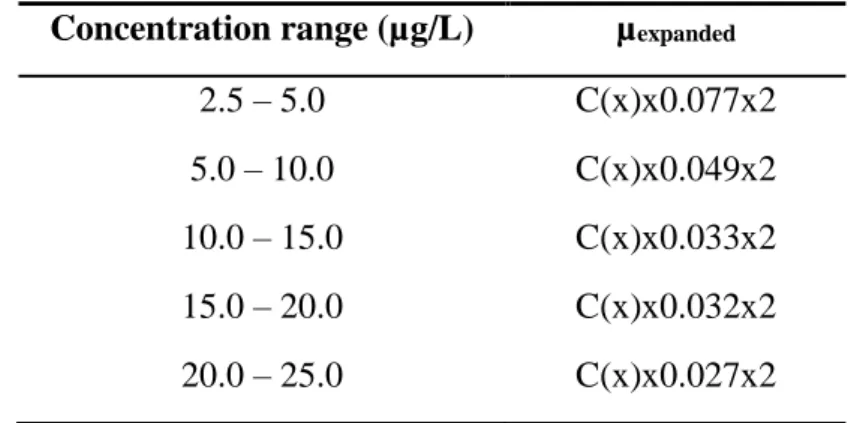BJRS
OF
RADIATION SCIENCES
07-02A (2019) 01-13 ISSN: 2319-0612 Accept Submission: 2018-10-31Development of a method for multielemental determination
in water by EDXRF with radioisotopic source of
238Pu.
Serrano C.
a, Estévez J.
a, Montero A.
a, Pupo I.
a, Herrero Z.
a, Leyva D.
a,
Van Espen P.
b, Arteche J.
a, Varcárcel L.
a, dos Santos Júnior J. A.
caChemical analysis department, Center of Technological Applications and Nuclear Development (CEADEN), St. 30th
#502 b/ 5ta and 7ma Avenue, Playa, Ciudad Habana, Cuba cserrano@ceaden.edu.cu
b Department of chemistry, University of Amberes, Prinsstraat 13, 2000 Antwerpen, Belgium cRadioecology Group, Department of Nuclear Energy, Center of Technology and Geosciences, Federal
University of Pernambuco, Av. Professor Luiz Freire, 1000, Cidade Universitária, 50740-545 Recife/PE, Brazil
ABSTRACT
A method for determination of Cr, Fe, Co, Ni, Cu, Zn, Hg and Pb in waters by Energy Dispersive X Ray Fluorescence (EDXRF) was implemented, using a radioisotopic source of 238Pu. For previous concentration was employed a
procedure including a coprecipitation step with ammonium pyrrolidinedithiocarbamate (APDC) as quelant agent, the separation of the phases by filtration, the measurement of filter by EDXRF and quantification by a thin layer absolute method. Sensitivity curves for K and L lines were obtained respectively. The sensitivity for most elements was greater by an order of magnitude in the case of measurement with a source of 238Pu instead of 109Cd, which means a
considerable decrease in measurement times. The influence of the concentration in the precipitation efficiency was evaluated for each element. In all cases the recoveries are close to 100%, for this reason it can be affirmed that the method of determination of the studied elements is quantitative. Metrological parameters of the method such as trueness, precision, detection limit and uncertainty were calculated. A procedure to calculate the uncertainty of the
method was elaborated; the most significant source of uncertainty for the thin layer EDXRF method is associated with the determination of instrumental sensitivities. The error associated with the determination, expressed as expanded uncertainty (in %), varied from 15.4% for low element concentrations (2.5-5 μg/L) to 5.4% for the higher concentration range (20-25 μg/L).
Keywords: multielemental determination, EDXRF, water.
1. INTRODUCTION
Nowadays, research on the study of pollutants affecting aquatic ecosystems has been of great interest because of the importance to protect the environment There are some products derived mainly from human activities and that once discharged to water bodies cause specific ecological alterations, such as "heavy metals".
Toxicity of these metals is related to their direct action on living beings, through the blocking of biological activities, causing irreversible damage to different organisms. The reaction of metallic cations with anionic sites on cell membranes or the ability of some ones to cross these membranes are clearly critical factors in many of their toxic actions. Due to their high affinity for proteins and many other biomolecules, these metals are not isolated in living systems [1].
Heavy metals are not biodegradable compared to other pollutants and natural waters are the main routes of their ecological cycle [2]. Accumulation in aquatic biota and in the human population is a risk factor since when these elements exceed the regulated concentration values, their toxicity increases considerably.
Some of the metals present in the waters represent a serious danger to public health and the environment due to they are not decomposed by the action of microorganisms, persisting in the environment indefinitely. The danger of these contaminants lies not only in their high stability and toxicity, but also in their accumulation in the food chain, which can reach very high concentrations in some organs of the last constituents of the chain, which often serve as food of human being [3]. Many analytical techniques have been employed for determination of metals in waters like Cr, Fe, Co, Ni, Cu, Zn, Hg and Pb. For example, Inductively Coupled Plasma Atomic Emission Spectrometry (ICP-AES) is one of the most used methods [4-7]. Inductively Coupled Plasma Mass Spectrometric (ICP-MS) has also been employed with different types of detection for Cr, Co, Cu, Zn, Hg, Pb determination [8-10].
The Energy Dispersive X Ray Fluorescence (EDXRF) is a cheap and express method for multielemental analysis but is not commonly used for metals determination in water samples due to the drawback for measurements of liquid matrix and low sensitivity. For these reasons, the general trend is to carry out a previous chemical concentration with the aim of converting the liquid matrix in solid samples with content sufficiently high of interest elements. Several examples of application of EDXRF combined with preconcentration methods for analysis of Co, Fe, Cu, Zn, Se and Pb has been reported [11-13].
At the present time, a lot of chemical preconcentration methods have been described such as ionic exchange, liquid-liquid extraction, precipitation, etc. One of more frequently used method is coprecipitation with organic or inorganic agents in the presence of a carrier. Selective precipitation of one element or a group of them is frequently used in analytical chemistry, but in EDXRF it is not necessary, even the non-specific precipitation can be an advantage [14].
The “Carbamates” family is one of the most studied as complexing agents due to the low solubility of their chelates. Many authors have used carbamates in precipitation steps for metals determination by EDXRF. For example, Ellys et al. [15] studied different methods for chemical preconcentration of trace elements like Cr, Mn, Fe, Co, Ni, Cu, Zn, As, Cd, Tl and Pb. In their studies they used the non-specific precipitation with sodium diethyldithiocarbamate (DDTC), ammonium pyrrolidinedithiocarbamate (APDC) and sodium dibenzildithiocarbamate (DBDTC), demonstrating that the greatest precipitation factor was for APDC and DBDTC. On the other hand, Orescanin et al. [16] reported a method for Cr determination in liquid samples using APDC as chelate agent.
Several studies reported shown the development of procedures for metals determination in water with previous precipitation using APDC. In all cases, a radioisotopic source of 109Cd was employed in measurement by EDXRF [12-13].
There is no evidence of application of 238Pu source of multielemental determination in water. The radioisotopic source of 238Pu has a half-life of 87,7 years whereas the one of 109Cd has only 453 days, this represent a clear advantage of 238Pu source, because it allow a much longer use than 109Cd source. Nevertheless, is necessary to consider that excitation mechanisms are different being more complex for 238Pu source.
In this work, a method for determination of Cr, Fe, Co, Ni, Cu, Zn, Hg and Pb in waters by EDXRF is implemented, using a radioisotopic source of 238Pu. Metrological parameters of the method are reported.
2. MATERIALS AND METHODS
2.1 Instrumental conditions
For measurements with radioisotopic source of 238Pu (789 MBq) was used an EDXRF spectrometer consisted of a Si(Li) detector (rε ≈ 200 eV for Mn-Kα), a digital signal processor (DSP) and a
computer coupled to the system. On the other hand, for measurements with radioisotopic source of
109Cd (~9 MBq) was used an EDXRF spectrometer consisted of a Si(Li) detector (rε ≈ 220 eV for
Mn-Kα), a multichannel analyzer (CANBERRA S30) and a computer coupled to the system. The spectrum fitting and quantification were performed with the QXAS-AXIL code [17] and the SAX application software [18].
Calculations were carried out using sensitivity calibration curves determined experimentally for Kα and Lα lines using standard filters MICROMATTER™, several high-purity metal foils and chemical reagents (Fig. 1).
2.2 Reagents and materials
All solutions were prepared using analytical grade chemicals and distilled and double deionized water (grade 2) [19]. MILLIOPORETM membrane filters (0.45 µm) were employed for filtrations. Stock solutions of Cr, Fe, Co, Ni, Cu, Zn, Hg and Pb (5 µg/mL for each metal) were obtained from 1000 µg/mL Certipur® standard. Moreover, solutions ranged 2.5 to 25 µg/L were prepared starting from multielemental solution of 5 µg/mL.
APDC solution (1%) was prepared daily by dissolving 0.25 g of APDC (Sigma) in 25 mL of water. The buffer solution (pH = 4) was obtained by mixing glacial acetic acid and sodium acetate, both from MERCK (Darmstadt, Germany). Cadmium carrier (100 µg/mL) was prepared from a Cd’Spectrosol’ standard solution (BDH).
2.3 General procedure
One liter of the solutions containing different concentrations (2.5 – 25 µg/L) of Cr, Fe, Co, Ni, Cu, Zn, Hg and Pb was treated with 500 mg of ammonium peroxidisulfate (oxidizing reagent) [20] in order to eliminate possible organic matter in the water. The solutions were boiled to destroy the oxidizing reagent excess.
The solution was cooled to room temperature and 500 µg of Cd carrier was added. After pH adjustment to 4 [21], 25 mL APDC (1%) solution was added. The sample was left to stand for 30 min. and the suspension was filtered through the membrane filter. The precipitate was air – dried and then analyzed by x-ray fluorescence, irradiated either with 238Pu or 109Cd sources.
The spectra were fitted with the AXIL software and the quantification was performed using SAX software. The above procedure was also applied to the blank sample. In order to evaluate the detection limits (DLs) as function of the measurement time and the source activity and type, the filters were measured at different time intervals using both sources.
2.4 Calibration curves
Calibration curves were obtained by plotting the peak area for each element versus concentration (µg/L). The linearity of the calibration was evaluated according to ISO Standard 8466 [22], which
verified its homogeneity and linearity (confidence level 95%). DL values (µg) were calculated by the Currie approach expressed by the following equation [23]:
(1)
IB,i – Intensity of the background under the analytical line of the i-th element (including the peak
area in blank measurements, if it is observed). Si – Sensitivity for the element i-th.
A – Sample area.
(Considering a sample total volume of 1000 mL, the DL can be expressed in µg/L)
3. RESULTS AND DISCUSSION
Taking into account the low values of sensitivity obtained (see Figure 1.) for each element with
109Cd source, it was decided to continue these studies using only the 238Pu source.
The calibration curves obtained for Cr, Fe, Co, Ni, Cu, Zn, Hg and Pb, show a good linearity between the count intensity and the added element concentration within the working interval (2.5 – 25 µg/L), as well as high correlation coefficients (Fig. 2).
Figure 3 shows the recovery values obtained during the precipitation of different amounts of studied elements with APDC and further determination by EDXRF using the 238Pu source. For different concentrations of these metals (2.5 – 25 µg/L) the recovery values for all of them were close to 100%. In addition, the results for both precision and bias are less than 10%. According to the International Atomic Energy Agency (IAEA) for the development of Proficiency Tests, acceptable precision values are considered up 15% [24].
3.1 Detection Limits
The DL, using Eqn. (1), range depending on the analyzed element and the measuring time (Fig. 4). These values are similar and sometimes lower than those obtained by other analytical techniques. For example, Cesur et al. [25] using a preconcentration method with diethyldithiocarbamates (DTCs), extraction in solid phase and measurements by Flame Atomic Absorption Spectrometry
(FAAS), obtained DLs values between 0,05-5 µg for Fe, Co, Ni, Cu, Zn, Hg and Pb. On the other hand, other authors [26] obtained DLs between 2-6 µg for Cr, Fe, Co, Ni and Cu using solvent extraction and measurements by Gas Chromatography (GC), High Performance Liquid Chromatography (HPLC) and FAAS.
Figure 4: DLs vs. measurement time for Cr, Fe, Co, Ni, Cu, Zn, Hg and Pb for 238Pu excitation.
In addition, it must be added that the detection limits obtained are lower than the admissible levels of trace elements for drinking water according to the United States Environmental Protection Agency (USEPA) [27] standards. Therefore, the described procedure can be useful for evaluating the quality of drinking water according to national and international standards.
3.2 Uncertainty calculation
The uncertainty calculation was made using the errors propagation. The most significant uncertainty source for the thin layer model is associated to the determination of instrumental sensitivities. In the table below (Table 1) are shown the combined uncertainty values expressed as expanded uncertainty for k=2, function of concentration. The associated error to determination, expressed as
expanded uncertainty (in %), range to 15.4% for low concentration of the elements (2.5 – 5 µg/L) to 5.4% for the major concentration values (20 – 25 µg/L).
Table I: Expanded uncertainty for k=2 Concentration range (µg/L) µexpanded
2.5 – 5.0 C(x)x0.077x2 5.0 – 10.0 C(x)x0.049x2 10.0 – 15.0 C(x)x0.033x2 15.0 – 20.0 C(x)x0.032x2 20.0 – 25.0 C(x)x0.027x2 C(x) – Concentration of the element in solution
4. CONCLUSION
A highly sensitive and relatively inexpensive method for the analysis of Cr, Fe, Co, Ni, Cu, Zn, Hg and Pb in water samples using APDC and EDXRF with radioisotopic source of 238Pu was implemented. The recovery values for all elements were close to 100% and the results for both accuracy and bias are less than 10%. The results using 238Pu and 109Cd source were very similar, but the 238Pu source is recommended owing to the lower measurement times. The DLs obtained are lower than the admissible levels of trace elements for drinking water according to national and international standards. The expanded uncertainty (in %), range to 15.4% for low concentration of the elements (2.5 – 5 µg/L) to 5.4% for the major concentration values (20 – 25 µg/L). Consequently, this analytical procedure can also be used alternatively for the determination of all these elements in water samples.
5. ACKNOWLEDGMENT
The authors greatly appreciate the help and support of the group of Chemical Analysis Laboratory at CEADEN.
REFERENCES
[1] YAGNENTOKOSKY, N. Aplicación de técnicas de biorremediación para el tratamiento de
residuos industriales con alto contenido de metales pesados (Doctoral dissertation, Facultad
de Ciencias Exactas, Departamento de Quimica, Universidad de la Plata, Argentina), (2011). Available at: <http://sedici.unlp.edu.ar/bitstream/handle/10915/2706/Documento completto.pdf?sequence=1>. Last accessed: 21 Apr. 2017.
[2] TAM, N. F. Y.; WONG, Y. S. Spatial and temporal variations of heavy metal contamination in sediments of a mangrove swamp in Hong Kong, Mar. Pollut. Bull., v 31(4), p. 254-261 (1995). [3] RUZA, F. Tratado Universal del Medio Ambiente, Madrid LAFFER, 1993.
[4] SERESHTI, H.; HERAVI Y. E.; SAMADI, S. Optimized ultrasound-assisted emulsification microextraction for simultaneous trace multielement determination of heavy metals in real water samples by ICP-OES. Talanta, 97, p. 235-241, 2012.
[5] KARIMI M.; SERESHTI H., KHOJEH V., SAMADI, S. Ligandless-ultrasound assisted emulsification microextraction followed by inductively coupled plasma optical emission spectrometry for simultaneous determination of heavy metals in water samples. Int. J. Environ.
Anal. Chem., v 93(4), p. 401-415, 2013.
[6] ZHAO L.; ZHONG S.; FANG K.; QIAN Z.; CHEN J. Determination of cadmium (II), cobalt (II), nickel (II), lead (II), zinc (II), and copper (II) in water samples using dual-cloud point extraction and inductively coupled plasma emission spectrometry. J. Hazard Mater., 239, p. 206-112, 2012.
[7] BAUER, G., NEOUZE, M. A., LIMBECK, A. Dispersed particle extraction—A new procedure for trace element enrichment from natural aqueous samples with subsequent ICP-OES analysis.
Talanta, 103, p. 145-152, 2013.
[8] YI, Y. Z.; WU, S. Y., JIANG S. J.; SAHAYAM, A. C. Cloud point extraction of Cr, Cu, Cd, and Pb from water samples and determination by electrothermal vaporization inductively coupled plasma mass spectrometry with isotope dilution. At. Spectrosc., 34(2), p. 39-47, 2013. [9] LIAO, P. H., JIANG, S. J., SAHAYAM, A. C. Cloud point extraction combined with flow
and determination of ultra trace Cd, Sb and Hg in water samples. J. Anal. At. Spectrom., 27(9), pp. 1518-1524, 2012.
[10] CHANDRASEKARAN, K.; KARUNASAGAR, D.; ARUNACHALAM, J. Dispersive liquid–liquid micro extraction of boron as tetrafluoroborate ion (BF4−) from natural waters, wastewater and seawater samples and determination using a microflow nebulizer in inductively coupled plasma-quadrupole mass spectrometry. J. Anal. At. Spectrom., 28(1), p. 142-149, 2013.
[11] KOCOT, K.; ZAWISZA, B.; SITKO, R. Dispersive liquid–liquid microextraction using diethyldithiocarbamate as a chelating agent and the dried-spot technique for the determination of Fe, Co, Ni, Cu , Zn, Se and Pb by energy-dispersive X ray fluorescence spectrometry.
Spectrochim. Acta Part B: At. Spectrosc., 73, p. 79-83, 2012.
[12] MONTERO, A.; ESTEVEZ, J.R.; PADILLA, R. Heavy metal analysis of rainwaters by nuclear related techniques: Application of APDC precipitation and energy dispersive X-ray fluorescence. J. Radioanal. Nucl. Chem., 245(3), p. 485-489, 2000.
[13] LEYVA, D.; ESTEVEZ, J.R.; MONTERO, A.; PUPO, I. Separation and determination of selenium in water samples by the combination of APDC coprecipitation: X-ray fluorescence spectrometry. J. Radioanal. Nucl. Chem., 291(3), p. 699-705, 2012.
[14] POBLETE, V. Desarrollo de técnicas de preparación de muestras, para análisis por
fluorescencia de rayos X. Informe técnico de la Comisión Chilena de Energía Nuclear
(CCHEN), Chile, 1998.
[15] ELLIS, A.T.; LEYDEN, D.E.; WEGSCHEIDER, W.; JABLONSKI, B.B.; BODNAR, W.B. Preconcentration methods for the determination of trace elements in water by x ray fluorescence spectrometry: Part 1. Response characteristics. Anal. Chim. Acta, 142, p. 73-87, 1982.
[16] ORESCANIN, V.; MIKELIC, L.; LULIC, S.; RUBCIC, M. Determination of Cr (III) and Cr (VI) in industrial and environmental liquid samples by EDXRF method. Anal. Chim. Acta, 527(2), p. 125-129, 2004.
[17] Quantitative X-Ray Analysis System (version 3.2), in Manual for QXAS/AXIL. 1995, IAEA: Vienna.
[18] TORRES, E.; FUENTES, M.; GREAVES, E.D. SAX, software for the analysis of x-ray fluorescence spectra. X-Ray Spectrom., 27, p.1661-165, 1998.
[19] ISO 3696, Water for Analytical Laboratory Use, Specification and test method 1987.
[20] HOLYNSKA, B. Sampling and sample preparation in EDXRS. X-Ray Spectrom., 22, p.192, 1993.
[21] MONTERO, A.; ESTEVEZ, J.R.; PADILLA, R. Heavy metal analysis of rainwaters by nuclear related techniques: Application of APDC precipitation and energy dispersive X-ray fluorescence. J. Radioanal. Nucl. Chem., 245, p. 485, 2000.
[22] ISO 8466-1, Water Quality – Calibration and Evaluation of Analytical Methods and Estimation of Performance Characeristics, Part 1: Statistical evaluation of the linear calibration function, 1990.
[23] CURRIE, L.A. Limits for qualitative detection and quantitative determination. Application to radiochemistry. Anal. Chem., 40(3), p. 586-593, 1968.
[24] SHAKHASHIRO, A. Regional PT on determination of trace elements in algae and water and radionuclides in soil and water, In Regional workshop on organization, evaluation and
reporting of IC/PTs, RLA/2/013 and RLA/2/014-002. Vienna, IAEA, 2007.
[25] CESUR, H. Solid-phase extractions with freshly precipitated metal-diethyldithiocarbamates and atomic absorption spectrophotometric determination of cooper. J. Trace Microprobe.
Tech., 21(4), p. 627-636, 2003.
[26] ARAIN, M.; KHUHAWAR, M.; BHANGER, M. Gas and liquid chromatography of metal chelates of pentamethylene dithiocarbamate. J. Chromatogr. A, 973(1), p. 235-241, 2000. [27] National Primary Drinking Water Regulations. Available at:
<https://www.epa.gov/ground-water-and-drinking-water/national-primary-drinking-water-regulations#Inorganic (2017)>. Last accessed: 19 Apr. 2017
